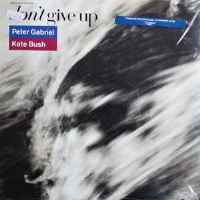
When Peter Gabriel left Genesis in 1977, many fans claimed it was the end of both his and Genesis’ career. When Phil Collins took over as lead vocalist, there was very mixed reaction, but whichever way you look at it, it was a good career move for both as Genesis became far more commercial and far more successful and Gabriel had a lucrative solo career. Genesis’ first UK hit with Phil up front was Follow You Follow Me which reached number seven in 1978 and Peter Gabriel’s first solo hit was Solsbury Hill which peaked at number 13 in 1977. Three years later he released Games Without Frontiers which, with the help of his friend Kate Bush on backing vocals, went to number four. It wasn’t to be the last time they shared a recording studio.
Peter Gabriel is probably best remembered for his hit Sledgehammer with its clever, innovative video, but the the video that accompanied Don’t Give Up was in stark contrast. It was just Peter Gabriel and Kate in an embrace for six and a half minutes. Gabriel had been married to Jill for 15 years and their marriage was on the rocks and when it came to making the video Gabriel still wanted to ring his wife and get her permission to embrace his duet partner. In an interview with Q magazine, Gabriel said, “I thought that five minutes of groping Kate in front of the world was perhaps not the best thing for a dodgy marriage. At the time I felt I needed a blessing. Anyway, Jill was great about it.”
The song opens with, ‘In this proud land we grew up strong, we were wanted all along. I was taught to fight, taught to win, I never thought I could fail’ and instantly sounds desperate and that’s exactly what it was. It was Jill who gave Peter the original inspiration after she’d read a newspaper article about a woman who was so down that she jumped from a high rise building with her child and ended her life. In an interview with Songfacts, Jill said, “I gave it to Peter and it was the original inspiration and he was heartbroken to read it.”
Two other influences have been cited by Gabriel, one is a television programme about unemployment and the other was some photographs he came across in a book called In This Proud Land – hence the song’s opening line. The book was published in the Depression-era in America in the 1930s. The photos were taken by the New Jersey-born Dorothea Lange whose parents were second-generation German immigrants. What struck Gabriel was the parallel he drew between the tragic loss the farmers suffered and the people who were suffering from the economic downturn during Margaret Thatcher’s time as PM.
The song was a very personal one for Gabriel as he was very close to a nervous breakdown and wanted to write the song to express his thanks to his family for the help they have given him during this tough time. He said, “Basically, handling failure is one of the hardest things we have to learn to do.” Jill was there by his side and one of the expressions she’d regularly say when she could see her husband was going through the emotional struggles was, ‘don’t give up’. Jill added, “I think the song is really about us.”
The song wasn’t originally written as a duet but then decided it should be, so he adjusted the lyrics so it fitted for two people to sing. Kate Bush was not his first choice of duet partner despite the success they’d have five years previous. He originally asked Dolly Parton but she turned the offered down. He said, when I first wrote it there was a reference to American Roots music so it was suggested that Dolly should sing on it. Dolly was reported as saying she turned it down because the song’s theme and style didn’t suit her country music image. It’s something he was later thankful for in light of how well the song turned out with Bush’s vocals.
He told Spin magazine in 1986, “The sensitive way that Kate handled the back and forth on that song was very gratifying because it’s not just about a woman supporting a man in a tough relationship, the other thing dragging me down is unemployment which was really tearing apart the social fabric of England at that time. Without a sense of self-esteem, it’s impossible to function.” In a comment he made in the Daily Mail, Gabriel admitted, “Kate played a big part in my rebirth, that record helped me so much.”
A few years later, Gabriel and Dolly Parton’s paths crossed again and in an interview with Spinner magazine, Gabriel said, “What’s funny is, we met a couple of times after that, and she ended up asking me to sing it with her on her TV show, but we were never able to make it happen.”
The song has been covered a number of times in duet form firstly in 1993 by Willie Nelson and Sinead O’Connor and appeared on Nelson’s album Across The Borderline, in 1999 with Clannad’s Máire Brennan and Michael McDonald collaborating, Alicia Keys & Bono did it as a charity song for Africa in 2005 and Donny Osmond & Laura Wright did it in 2014. In a solo version, it was covered by ex-Shalamar singer Jody Watley in 2001 and Heart’s Ann Wilson in 2016 and there was even a three-way collaboration in 2010 between Herbie Hancock, P!nk and John Legend. Regardless of who sings it, the strong message of ‘don’t give up’ when life looks bleak remains strong.